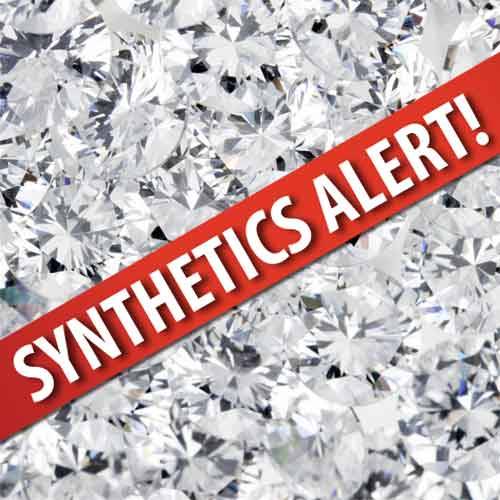|
News
Articles from DIAMOND GRADING / CERTIFICATION (79 Articles)

Australian diamond grading labs are confident disclosure of synthetic diamonds is accurate across Australia
Diamond labs reassure industry
 3.1 k views | Posted June 05, 2012 3.1 k views | Posted June 05, 2012 | By Dean Millard • Staff Journalist
Australian diamond grading laboratories are unconcerned by the discovery
of a large parcel of synthetic diamonds at an Antwerp grading lab.
Australia’s diamond grading laboratories have moved to reassure the industry following news of a diamond trader submitting synthetic diamonds as natural diamonds for testing in Antwerp.
The unnamed international diamond dealer is reported to have purchased a package of 600 diamonds of which testing revealed 145 to be synthetics, although some reports have the numbers as high as 1,000 and 600 synthetics.
The discovery was made at the International Gemological Insitute’s (IGI) Antwerp lab. The diamond dealer claims to have made the purchase on the understanding that all of the stones were natural.
Initial news reports said the diamond trader had selected the stones from a larger selection of about 1,000 stones, sparking concerns that there may be more synthetic stones under the guise of natural stones circulating in the market, however two of Australia’s diamond grading labs have moved to quell those concerns.
Anthony Bates, director Scientific Gem Testing Laboratory (SGTL) responded to Jeweller’s inquiries, saying that the grading laboratory’s job was to identify synthetic stones, which it had done, and the only danger to the industry was for the story to be blown out of proportion.
“The only threat to the industry would be if the scaremongers get a hold of the story and blow it out of proportion. The number of [synthetic] stones identified is actually minute as a proportion of the stones graded each month ” Bates said.
“If a large lab identified, say, 300 synthetic stones and it graded 30,000 in a year, then that’s only one per cent,” Bates explained. He urged anyone with concerns about the origins of diamonds to buy stones certified by established and respected grading houses.
Gemological Association of Australia committee member Ronnie Bauer, who also owns Bauer Gemological Laboratories, said while he was aware of the situation recently in Antwerp he was confident the Australian market had no issues with synthetic diamonds being sold as natural stones.
“I am really pleased to say that in Australia I have not come across this problem, the disclosure here is actually quite good,” Bauer said. “Even the people who sell synthetic [diamonds] are very upfront about it.”
Bauer agreed with the Bates that the major threat the discovery of these stones had to the industry was in the reporting of the matter, saying irresponsible reporting could damage the image of the industry unnecessarily.
“The spin that can be put on this with some slight massaging of the situation could create far more scaremongering than what the actual facts are in the situation,” Bauer said.
Some industry experts believe that the synthetic stones that were discovered in Antwerp were deliberately designed to appear as natural stones because they included minor inclusions consistent with the look of natural stones.
Roland Lorié, the co-chief executive officer of IGI, was reported in Rapaport News as saying a diamond dealer would not be able to differentiate between the synthetic diamonds in question and natural ones without the assistance of the sophisticated machinery used by the grading labs. Chemically and physiologically the stones are diamonds, with the difference being the origin and method of construction.
Given that even a dealer experienced with handling diamonds cannot tell the natural from the synthesised apart, the certification of the stones becomes all the more important for the confidence of the consumer in knowing what it is they are purchasing.
Bauer said the story behind a diamond and the perceptions that come with it are important to consumers and why it was important to ensure complete disclosure of exactly what a stone is.
“If I put two stones in my hands and put them out and said the left hand has a synthetic diamond and the right hand has a natural one, which one are you going to take? It is a question of perception. People want the natural diamond,” Bauer said.
Bauer advised those working in the industry to maintain their training through courses such as those offered by the GAA as the more educated those in the industry are the more confidence consumers would have in them.
“There are very good gem and diamond grading laboratories in Australia, all very competent, and I am speaking as a GAA board member, not a lab owner. If people have any doubt at all please send it to one of those labs for verification.”
Leading Australian diamond expert Gary Holloway said 95 per cent of the diamonds on the market were type one diamonds and all synthetic stones were type two, so people only need to check and send the type two to labs for testing.
“This is important because it is hard for producers to make large diamonds and easier to put small fakes into parcels if one wants to cheat,” Holloway said. “Small stones are never sent to labs.”
Holloway said he had also introduced the GAA and National Council of Jewellery Valuers to Branko Deljanin who developed a method to identify chemical vapour disposition (CVD) diamonds using an inexpensive instrument called a polariscope. Holloway hopes Deljanin will visit Australia to run training courses.
Ultimately though, Holloway said the best way the industry could protect itself is through knowing the history of what they buy and who they are buying from.
“The best way for the trade to protect itself and its consumers from this threat is to know who you bought from – so when or if synthetics find their way into the market it is simply a matter of back tracking through the supply channel and identifying the source. They will be booted out of Bourses [diamond trading business], black listed and bankrupted.
Holloway is currently at the JCK jewellery show in Las Vegas and added, “While here in Vegas I have heard two plausible sources [of the synthetic batch] – and both involve very, very short supply chains – so we will not have a problem.”
More reading
Lab-grown diamonds to take off?
|
|
Search for Diamond Grading / Certification
|
|